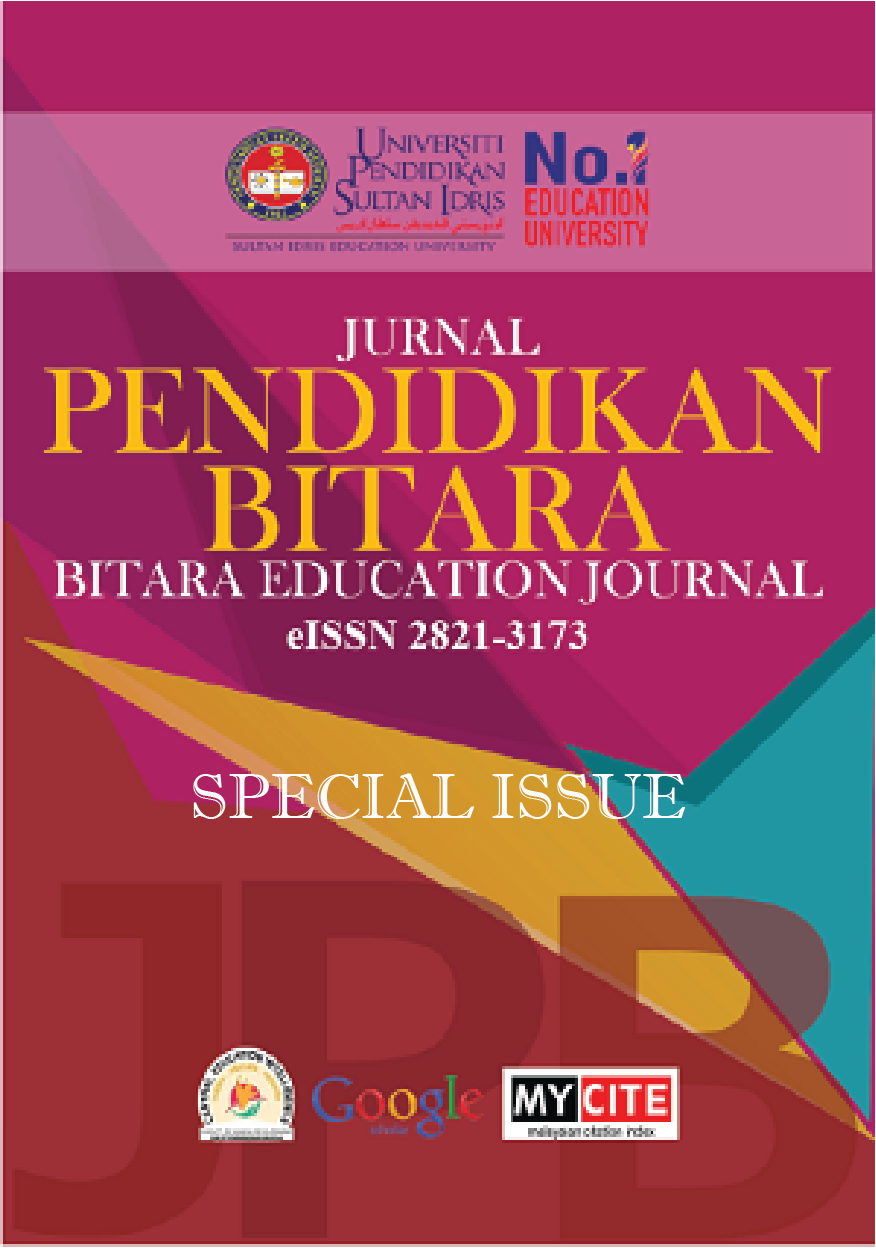Academic Achievement of Children with Deafness or Hard of Hearing (DHH) Inclusive Educational Setting: A Scoping Review
DOI:
https://doi.org/10.37134/bitara.vol17.sp.6.2024Keywords:
Academic achievement, deafness, hard-of-hearing, inclusive educationAbstract
Education for children who are deaf or hard of hearing (DHH) has resulted in various outcomes. In the move to inclusivity, scarce studies have been conducted to evaluate the academic achievement of DHH children, especially in the inclusive education (IE) setting. Therefore, this review aims to map the literature about the academic achievement of children with DHH within IE settings worldwide, including the assessment tools and interventions received. Data were searched from five electronic databases: EBSCOhost [Academic Search Complete (ASC), MEDLINE and CINAHL], Science Direct, SCOPUS, PubMed (PMC) and ERIC (Education Resources Information Centre). Six studies were found to fulfil the inclusion criteria: investigated the achievement of students with DHH academically and in inclusive educational settings. These studies were organised based on the Problem-Intervention-Outcome Meta-Model (PIO MM) conceptual model. In this model, the problem (population of children with DHH) with the intervention [hearing device(s) used, communication mode, classroom type, and therapy received] and outcomes (academic achievement) were analysed. The resulting studies were conducted in Taiwan, the United States, the Netherlands, and Canada. This study described academic achievement using different tools. This review also showed that most of the studies focused on students with a cochlear implant(s) who usually had severe to profound hearing loss. Communication had been rated as a lower achievement by the classroom teachers and formal examinations. With the mapped findings from the scoping review, future research could focus on various degrees of loss, the hearing devices used, and their relationship to educational outcomes, especially in the IE setting.
Downloads
References
Arksey, H., & O’Malley, L. (2005). Scoping studies: Towards a methodological framework. International Journal of Social Research Methodology: Theory and Practice, 8(1), 19–32. https://doi.org/10.1080/1364557032000119616
Boothroyd, A., & Boothroyd-Turner, D. (2002). Postimplantation audition and educational attainment in children with prelingually acquired profound deafness. Annals of Otology, Rhinology and Laryngology, 111(5 II), 79–84. https://doi.org/10.1177/00034894021110s517
Camarata, S., Werfel, K., Davis, T., Hornsby, B. W. Y., & Bess, F. H. (2018). Language abilities, phonological awareness, reading skills, and subjective fatigue in school-age children with mild to moderate hearing loss. Exceptional Children, 8(44), 420–436. https://doi.org/https://doi.org/10.1177/0014402918773316
Corsi-Bunker, A. (2011). Guide to the Education System in the United States. isss.umn.edu/publications/USEducation/
Cupples, L., Ching, T. Y. C., Crowe, K., Seeto, M., Leigh, G., Street, L., Day, J., Marnane, V., & Thomson, J. (2014). Outcomes of 3-year-old children with hearing loss and different types of additional disabilities. Journal of Deaf Studies and Deaf Education. https://doi.org/10.1093/deafed/ent039
Damen, G. W. J. A., van den Oever-Goltstein, M. H. L., Langereis, M. C., Chute, P. M., & Mylanus, E. A. M. (2006). Classroom performance of children with cochlear implants in mainstream education. Annals of Otology, Rhinology and Laryngology, 115(7), 542–552.
Langereis, M., & Vermeulen, A. (2015). School performance and wellbeing of children with CI in different communicative-educational environments. International Journal of Pediatric Otorhinolaryngology, 79(6), 834–839. https://doi.org/10.1016/j.ijporl.2015.03.014
Machts, N., Kaiser, J., Schmidt, F. T. C., & Möller, J. (2016). Accuracy of teachers’ judgments of students’ cognitive abilities: A meta-analysis. Educational Research Review, 19, 85–103. https://doi.org/10.1016/j.edurev.2016.06.003
McCain, K. G., & Antia, S. D. (2005). Academic and social status of hearing, deaf, and hard of hearing students participating in a co-enrolled classroom. Communication Disorders Quarterly, 27(1), 20–32. https://doi.org/10.1177/15257401050270010201
Pan, Y. Y. (2016). Education in China: A Snapshot. Secretary-General of the OECD, 1–68. https://www.oecd.org/china/Education-in-China-a-snapshot.pdf
Peters, M. D. J., Godfrey, C. M., Khalil, H., McInerney, P., Parker, D., & Soares, C. B. (2015). Guidance for conducting systematic scoping reviews. International Journal of Evidence-Based Healthcare, 13(3), 141–146. https://doi.org/10.1097/XEB.0000000000000050
Peters, M. D. J., Marnie, C., Tricco, A. C., Pollock, D., Munn, Z., Alexander, L., McInerney, P., Godfrey, C. M., & Khalil, H. (2020). Updated methodological guidance for the conduct of scoping reviews. JBI Evidence Synthesis, 18(10), 2119–2126. https://doi.org/10.11124/JBIES-20-00167
Reed, S., Antia, S. D., & Kreimeyer, K. H. (2008). Academic status of deaf and hard-of-hearing students in public schools: Student, home, and service facilitators and detractors. Journal of Deaf Studies and Deaf Education. https://doi.org/10.1093/deafed/enn006
Sarant, J. Z., Harris, D. C., & Bennet, L. A. (2015). Academic outcomes for school-aged children with severe–profound hearing loss and early unilateral and bilateral cochlear implants. Journal of Speech Language and Hearing Research. https://doi.org/10.1044/2015_JSLHR-H-14-0075
UK Department for Education. (2014). The national curriculum in England: Framework document. In Department for Education (Issue December). www.gov.uk/dfe/nationalcurriculum
Vermeulen, A., de Raeve, L., Langereis, M., & Snik, A. (2012). Changing realities in the classroom for hearing-impaired children with cochlear implant. Deafness and Education International, 14(1), 36–47. https://doi.org/10.1179/1557069X12Y.0000000004
Wu, C. M., Liu, T. C., Liao, P. J., Chen, C. K., Chang, B. L., & Lin, B. G. (2013). Academic achievements and classroom performance in Mandarin-speaking prelingually deafened school children with cochlear implants. International Journal of Pediatric Otorhinolaryngology, 77(9), 1474–1480. https://doi.org/10.1016/j.ijporl.2013.06.012
Yoshinaga-Itano, C. (1999). Benefits of early intervention for children the role of degree of hearing loss. Otolaryngologic Clinics of North America, 32(6), 1089–1102
Downloads
Published
Issue
Section
License
Copyright (c) 2024 Aw Cheu Lih, Lee Lay Wah, Mohd Fadzil Nor Rashid , Aznan Che Ahmad

This work is licensed under a Creative Commons Attribution-NonCommercial-ShareAlike 4.0 International License.





